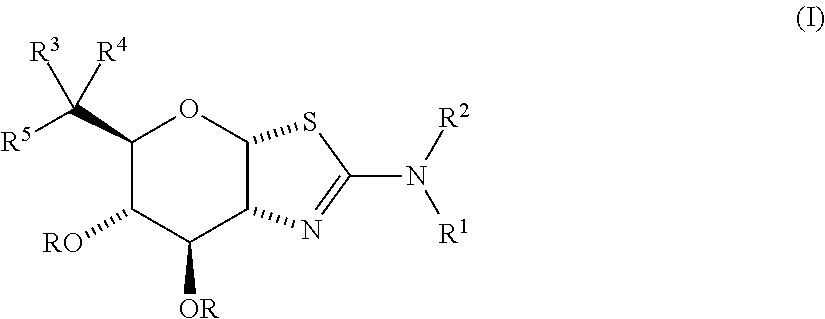Selective glycosidase inhibitors and uses thereof
- Summary
- Abstract
- Description
- Claims
- Application Information
AI Technical Summary
Benefits of technology
Problems solved by technology
Method used
Image
Examples
example 1
(3aR,5R,6S,7R,7aR)-2-(Dimethylamino)-5-((S)-1-hydroxyethyl)-5,6,7,7a-tetrahydro-3aH-pyrano[3,2-d]thiazole-6,7-diol
[0143]
[0144]Step 1
(3aR,5R,6S,7R,7aR)-5-(Acetoxymethyl)-2-(dimethylamino)-5,6,7,7a-tetrahydro-3aH-pyrano[3,2-d]thiazole-6,7-diyl diacetate (6)
[0145]To a solution of (3R,4R,5S,6R)-6-(acetoxymethyl)-3-isothiocyanato-tetrahydro-2H-pyran-2,4,5-triyltriacetate (2 g, 5.14 mmol) in dichloromethane (20 mL) was added dimethylamine hydrochloride (460 mg, 5.64 mmol) and triethylamine (675 mg, 6.68 mmol) at 5-10° C. After stirred for 3 h, the reaction mixture was treated with TFA (1.6 g, 14 mmol) overnight at room temperature. The reaction mixture was washed with saturated sodium bicarbonate (50 mL), dried over anhydrous magnesium sulfate, and concentrated under vacuum to provide a residue, which was purified by silica gel column, eluted with 1% MeOH in dichloromethane to give compound 6 as yellow oil (1.65 g, 85%). (ES, m / z): [M H]+ 374.9; 1H NMR (300 MHz, CDCl3) δ 6.24-6.26 (d, J=6...
example 2
(3aR, SR, 6S,7R,7aR)-5-((S)-1-hydroxyethyl)-2-(propylamino)-5,6,7,7a-tetrahydro-3aH-pyrano[3,2-d]thiazole-6,7-diol
[0161]
[0162]Step 1
(3aR,5R,6S,7R,7aR)-5-(Acetoxymethyl)-2-(propylamino)-5,6,7,7a-tetrahydro-3aH-pyrano[3,2-d]thiazole-6,7-diyl diacetate (14)
[0163]To a solution of (3R,4R,5S,6R)-6-(acetoxymethyl)-3-isothiocyanato-tetrahydro-2H-pyran-2,4,5-triyltriacetate (59 g, 151 mmol) in dichloromethane (500 mL) was added propan-1-amine (9.4 g, 159 mmol) dropwise with stirring at 0° C. After stirred for 1 h, the reaction solution was treated with trifluoroacetic acid (130 g, 1.34 mol) overnight at room temperature. The reaction mixture was washed with saturated sodium bicarbonate (300 mL), dried over anhydrous magnesium sulfate, and concentrated under vacuum to provide a residue, which was purified by silica gel column, eluted with 1% MeOH in dichloromethane to give compound 14 as a yellow oil (50 g, 84%). (ES, m / z): [M+H]+ 388.9; 1H NMR (300 MHz, CDCl3) δ 6.14-6.16 (d, J=6.6 Hz, 1H), ...
example 3
(3aR,5S,6S,7R,7aR)-5-(2-Hydroxypropan-2-yl)-2-(methylamino)-5,6,7,7a-tetrahydro-3aH-pyrano[3,2-d]thiazole-6,7-diol
[0181]
[0182]Step 1
(3aR,5R,6S,7R,7aR)-5-(Acetoxymethyl)-2-(methylamino)-5,6,7,7a-tetrahydro-3aH-pyrano[3,2-d]thiazole-6,7-diyl diacetate (23)
[0183]To a solution of (3R,4R,5S,6R)-2,4,5-triacetoxy-6-(acetoxymethyl)-tetrahydro-2H-pyran-3-aminium chloride (100 g, 261 mmol) in CH3CN (1 L) was added methyl isothiocyanate (21 g, 287 mmol), triethylamine (29 g, 287 mmol). After stirred for 12 h at 60° C., the resulting solution was treated with TFA (110 g, 0.96 mol) at room temperature overnight, and then washed with saturated sodium bicarbonate (1 L). The organic layer was dried over magnesium sulfate and concentrated under vacuum to provide a residue, which was purified by silica gel column, eluted with 1% MeOH in dichloromethane to give compound 23 as a yellow oil (150 g, 87%). (ES, tri / z): [M+H]+ 360.9; 1H NMR (300 MHz, CDCl3) δ 6.31-6.33 (d, J=6.6 Hz, 1H), 5.41-5.48 (t, J=8....
PUM
| Property | Measurement | Unit |
|---|---|---|
| Molar density | aaaaa | aaaaa |
| Molar density | aaaaa | aaaaa |
| Molar density | aaaaa | aaaaa |
Abstract
Description
Claims
Application Information
 Login to view more
Login to view more - R&D Engineer
- R&D Manager
- IP Professional
- Industry Leading Data Capabilities
- Powerful AI technology
- Patent DNA Extraction
Browse by: Latest US Patents, China's latest patents, Technical Efficacy Thesaurus, Application Domain, Technology Topic.
© 2024 PatSnap. All rights reserved.Legal|Privacy policy|Modern Slavery Act Transparency Statement|Sitemap



